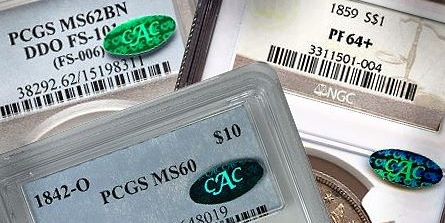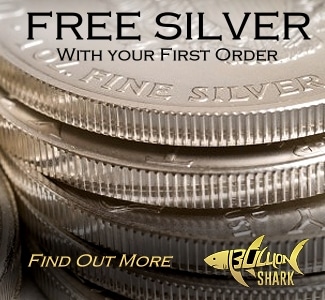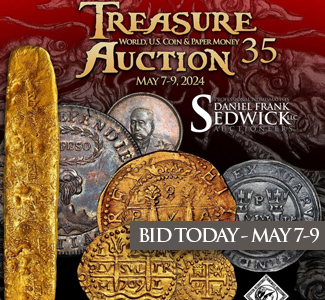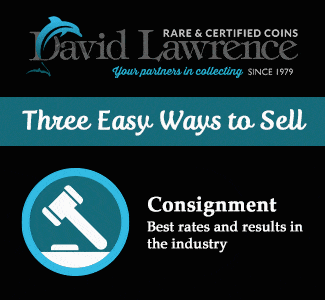 Coins that have been reviewed and stickered by Certified Acceptance Corporation (CAC) consistently bring premiums over other “non-stickered” coins in the marketplace. Below are some examples from recent actions sales on March 2018 one may use for a refference.
Coins that have been reviewed and stickered by Certified Acceptance Corporation (CAC) consistently bring premiums over other “non-stickered” coins in the marketplace. Below are some examples from recent actions sales on March 2018 one may use for a refference.
Here are 10 examples among many that could be listed:
- On March 4, GreatCollections sold a CAC-approved, EF-40 1903-S Morgan silver dollar for $357.75 USD. On March 6, Heritage sold a certified EF-40 1903-S, without a CAC sticker, for $253.20. In January, Heritage sold a certified EF-40 1903-S silver dollar without CAC approval for $312. In October 2017, another major auction firm sold one for $288.
- On March 4, an NGC-graded AU-58 1911-S $10 gold coin, with a CAC sticker, realized $3,046.50. On February 23, Heritage auctioned a certified AU-58 1911-S, without a CAC sticker, for $2640.
- On March 11, GreatCollections sold a CAC-approved “MS-67” 1914-D dime for $8,493.75. Representative auction results for non-CAC “MS-67” dimes are: $3,290 in March 2016 in Baltimore; $4,700 in March 2015; $5,462.50 in January 2012; $3,335 in September 2010 at the Long Beach Expo; $2,300 in February 2010; and $2,760 in July 2009. The same CAC 1914-D that GreatCollections just sold was auctioned in December 2014 for $8,518.75. A different CAC MS-67 1914-D was auctioned for $6,900 in April 2011. Clearly, CAC MS-67 1914-D dimes have been bringing much more than non-CAC MS-67 1914-D dimes.
- On March 11, GreatCollections sold a CAC-approved “MS-65” 1928 Hawaiian commemorative half dollar for $3,543.75. Heritage recently auctioned two certified “MS-65” 1928 Hawaiian halves, each without a CAC sticker, for $2,880 on February 23 and for $2,640 on March 31.
- On March 18, GreatCollections sold a CAC-approved, ‘MS-67 Red’ 1947 Lincoln cent for $6,469.88. Four days later, Stack’s-Bowers auctioned a certified ‘MS-67 Red’ 1947 in a major collection, but without a CAC sticker, for $1,440. In November 2017, Heritage sold a certified ‘MS-67 Red’ 1947 Lincoln for $1,080.
- On March 22, Stack’s-Bowers auctioned a CAC-approved ‘MS-67 Red’ 1927 Lincoln cent for $5,280. About a month earlier, Heritage auctioned a 1927 Lincoln cent with the same certification but without a CAC sticker for $1,440. In November 2017, Heritage auctioned another with this same certification, also without a CAC sticker, for $1,020.
- On March 22, Stack’s-Bowers auctioned a CAC-approved ‘MS-66 Red’ 1930-S Lincoln cent for $1,320. So far this year, Heritage has sold two certified ‘MS-66 Red’ 1930-S Lincoln cents, without CAC stickers, for $360 in February and for $528 in January. In October 2017, GreatCollections sold a ‘MS-66 Red’ 1930-S, without a CAC sticker, for $596.25.
- On March 22, Stack’s-Bowers auctioned a CAC-approved MS-64 1925-D $20 gold coin for $31,200. Heritage auctioned a non-CAC MS-64 1925-D for $12,512.50 in April 2017 and another for $14,100 in January 2017.
- On March 22, Stack’s-Bowers auctioned a CAC-approved MS-64 1850-O half dollar for $7,800. Since coin markets peaked in the middle of 2008, there have been more than a half-dozen auction appearances of non-CAC 1850-O halves that are certified as MS-64 or “MS-64+” and not one of them sold for as much as $3550.
- On March 22, Stack’s-Bowers auctioned a CAC-approved MS-64 1889 half dollar for $2,640. A month earlier, Heritage auctioned a certified MS-64 1889 half, without a CAC sticker, for $1500.





I’m not a fan of CAC. The top slab companies do their jobs just fine. Coins of with the same grade do look different, but that’s why a buyer should always still look at the coin. I guess CAC would be good for sight-unseen coins, and maybe really expensive ones (like over 1k). Otherwise, it’s an erroneous service in my opinion.
I think CAC serves a valid purpose but they have a strong tendency to sticker coins with ugly, brown spot mottled toning. I would never buy one of these just because it has a CAC sticker.